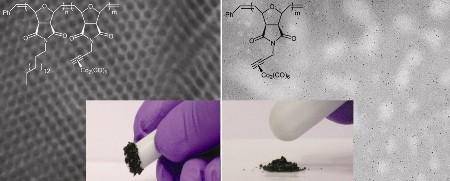Research teams at the University of Massachusetts have developed an easy way to create magnetic materials at room temperatures from nanostructures.
 Figure shows the block copolymer (left) and homopolymer (right) samples. The background of both figures is a transmission electron microscopy image showing that the block copolymer is made of nanoscopic domains visualized as a honeycomb pattern of cobalt-rich cylinders while the homopolymer is unstructured but contains small cobalt particles shown in black. Similar small cobalt particles are present in the block copolymer but they are not easily observed due to the nanoscopic block copolymer super-structure. The chemical structure of both polymers is also shown along with powder samples of the two materials. The block copolymer is attracted to the white magnet bar shown in the photograph while the non-magnetic homopolymer sample has no such attraction.
Figure shows the block copolymer (left) and homopolymer (right) samples. The background of both figures is a transmission electron microscopy image showing that the block copolymer is made of nanoscopic domains visualized as a honeycomb pattern of cobalt-rich cylinders while the homopolymer is unstructured but contains small cobalt particles shown in black. Similar small cobalt particles are present in the block copolymer but they are not easily observed due to the nanoscopic block copolymer super-structure. The chemical structure of both polymers is also shown along with powder samples of the two materials. The block copolymer is attracted to the white magnet bar shown in the photograph while the non-magnetic homopolymer sample has no such attraction.
According to Gregory Tew who is a polymer scientist at the university’s Amherst, the new procedure involves coding a block copolymer with the required chemical information and placing it on a cobalt nanostructure. After this, heat at a very low temperature of 200 ° C is applied. The combined properties of the cobalt nanostructure and the copolymers create fully magnetic materials at room temperature.
The methods, which are applied at present require many steps to create magnetic materials, are not very effective in creating magnetic materials and are expensive. The new method is very cost-effective as it involves only one step. The copolymers that organise themselves into nanoscopic domains through this method are just one millionth of a millimetre thin in nature. Scientists have also discovered that the copolymers can be made to organise over long ranges to create materials with better magnetic properties. They can also be organised over greater areas. Magnetic materials produced through this method can be used in spintronic devices, memory media and giant devices that are resistant to magnets. Different types of metals can also be added to this process to increase its effectiveness.
Source: http://www.umass.edu